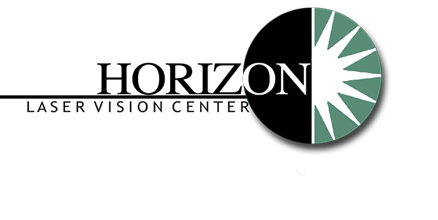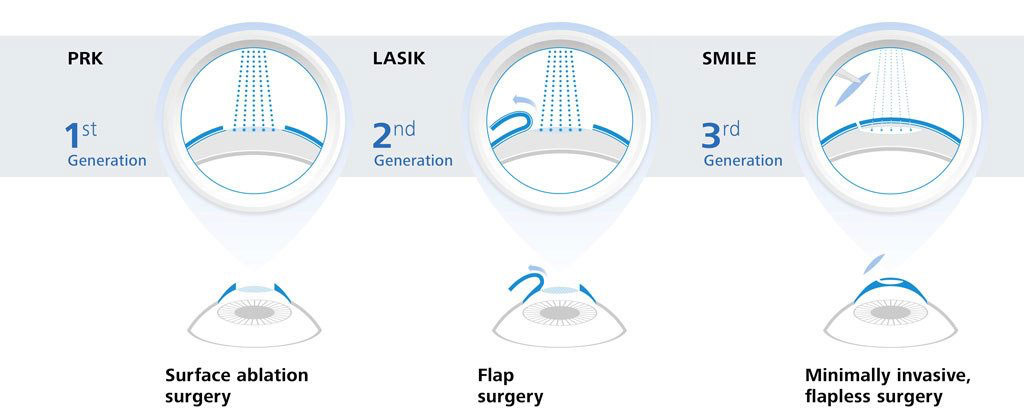
SMILE, LASIK, or PRK: Which is Right for Me?
If you’re ready to live your life free from glasses and contacts, you’ve probably decided that laser eye surgery is the best option for you. Knowing which procedure is the best for you can be a bit more difficult. Those who have chosen laser eye surgery find themselves weighing the three best options: SMILE, LASIK or PRK Surgery.
All three surgeries are trusted, safe, and effective ways to correct your vision. But which procedure is best?
1st Generation: PRK
(Photorefractive Keratectomy)
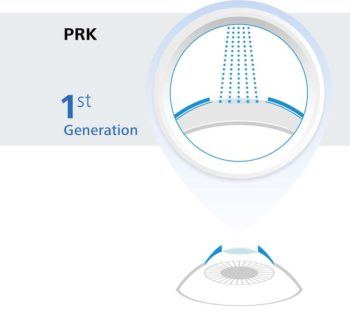
PRK is considered by many to be the first generation of laser vision correction. PRK can treat nearsightedness, farsightedness, and astigmatism.
During a PRK procedure, the outer layer of your cornea (also known as the epithelium) is gently removed using a manual instrument. Your surgeon then uses a cool excimer laser to reshape your cornea and correct your vision.
When is PRK a Good Option?
PRK is a good option for patients with thin or irregular corneas, patients who are predisposed to chronic dry eye, and patients whose jobs or lifestyles cause them to take a lot of direct contact to the eyes (Ex: Boxers and fighters). Thin corneas, dry eye, and high-risk occupations can cause a patient to not be a suitable candidate for LASIK (but still may be a great candidate for SMILE, which we’ll get to later).
PRK Downsides
The major downside with PRK is recovery time: PRK has the longest recovery period out of all three laser eye surgeries. It takes about a week for the cells on the outer layer of your cornea to grow back. It can then take anywhere from two to six weeks for the cells to smooth and allow for clear vision.
If you were to elect to have PRK done in both eyes at once (which is an option) a patient will typically need to take a week off of work or driving.
There is also a higher chance of post-surgery discomfort when compared to SMILE or LASIK.
2nd Generation: LASIK
(Laser-Assisted Stromal In-situ Keratomileusis)
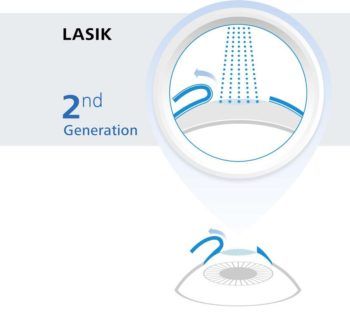
The majority of our new patients are most familiar with LASIK eye surgery. This is because LASIK is the most commonly performed laser eye surgery in practice today.
LASIK can treat mild to moderate nearsightedness, farsightedness, and astigmatism.
During a LASIK procedure, a small flap of corneal tissue is created using a femtosecond laser and then folded back. Your surgeon will then use an excimer laser to reshape the underlying corneal tissue in order to correct your vision.
When is LASIK a Good Option?
In order to be a good candidate for LASIK, a patient needs to have an adequate corneal thickness. Since a flap is created during this procedure, a certain amount of corneal thickness is required and those with thin or irregular corneas may be unable to receive LASIK. Patients with thin or irregular corneas are typically better candidates for SMILE or PRK.
If a patient is predisposed to chronic dry eye symptoms, SMILE or PRK may be a better option. LASIK is known to run a higher risk for postoperative dry eye symptoms and can increase previously held chronic dry eye.
LASIK Downsides
LASIK is an extremely effective, safe, and trusted option. Its one downside is it is a more complex procedure than its successor, SMILE, because it uses two lasers and creates a flap during surgery. Because of this, there is a potential for flap-related complications post-surgery.
Flap-related complications include microscopic wrinkles called striae, irregular astigmatism, epithelial ingrowth, inflammation, and dry eye syndrome. Flap-related complications are rare and your chance of encountering these complications are greatly decreased by partnering with an experienced surgeon like Dr. Jay Bansal.
3rd Generation: SMILE
(Small Incision Lenticule Extraction)
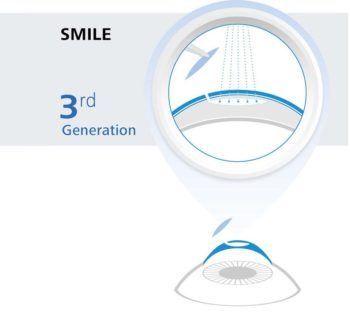
SMILE laser eye surgery is the most advanced FDA approved laser vision correction procedure to date. SMILE has been in practice worldwide since 2012, and was approved for widespread use in the United States in 2016.
One-Step One-Laser Procedure
One of the main differences between SMILE and its predecessors is it is a one-laser procedure. Unlike PRK and LASIK, there is no use of an excimer laser during a SMILE procedure. Instead, your surgeon will use a femtosecond laser to cut a tiny incision in the cornea and use it to remove a small piece of corneal tissue (called a lenticule). This reshapes the cornea and improves vision.
Less Invasive Surgery
SMILE is a less invasive laser eye surgery procedure than LASIK. During a LASIK procedure, your surgeon creates a flap that is 20mm in circumference. A PRK procedure creates an 8mm diameter surface removal. In comparison, SMILE creates only a 3mm corneal key-hole incision. This allows for more corneal stability post-surgery and less disturbance to corneal nerves during surgery.
Quiet, Odorless, and Blade-Free
During both LASIK and PRK, an excimer laser is used to reshape the cornea. During surgery, this laser makes a clicking sound and creates a noticeable odor. Since the excimer laser is not used during SMILE, the procedure is quiet and odorless.
No Flap-Related Complications
Because SMILE does not create a flap like LASIK, there is no risk of flap-related complications after surgery.
Safe, Accurate, and Fast Visual Recovery
Clinical trials for SMILE have found it to be just as safe and accurate as LASIK.
SMILE Downsides
The one downside to SMILE is that it is not yet available to treat farsightedness or astigmatism. SMILE is currently only available to treat certain types of nearsightedness.
In addition, visual recovery takes a slightly longer time than compared to LASIK. With a LASIK procedure, a patient can experience instant visual recovery. SMILE’s visual recovery can take about one to two days.
SMILE Laser Eye Surgery at Horizon Laser Vision Centre .
SMILE is considered the most significant advance in laser eye surgery technology in over 10 years. It combines the safety of traditional vision correction techniques with even greater comfort and potentially greater precision.
Which is Right for Me?
Ultimately, only a comprehensive eye exam and consultation by your surgeon can determine which procedure is the best for you. If you would like to learn if SMILE, LASIK or PRK is the best option for you, call or schedule your consultation online today.
Am I a Candidate?
Perhaps the greatest news about SMILE is that the majority of people with nearsightedness, farsightedness as well as astigmatism are candidates for this state-of-the-art vision correction procedure. With the use of a bladeless no-flap creator, and the wide range of vision imperfections that the FDA-approved treatment laser can correct, more people than ever before are excellent candidates for laser vision correction. If you answer “true” to all the following criteria, it’s time for you to schedule an evaluation with our office today!
• I am in overall good health.
• I have had a stable eye prescription for at least one year.
• I have no existing eye diseases.
• I am at least 18 years old.
• I want to change my life and lifestyle with freedom from glasses and contacts.
Horizon Laser Vision Center is a laser clinic operated by 85 Saskatchewan optometrists and ophthalmologists with clinics in both Regina and Saskatoon, and have performed refractive surgery on ten of thousands of patients since 1996.
The clinic was founded on the belief that it is in the patient’s best interest to have their pre- and post-operative care provided by their own eye doctor. Horizon is committed to the patient’s right to choose both the type of surgery and their surgeon.
This unique partnership with eye doctors is to provide centres of excellence by having well trained staff, optometrists and eye surgeons, and providing them with the most current laser technology . Horizon is also committed to providing its doctors with continuing education to maintain the highest standards of patient care.
The Spectrum Eye Centre has partnered with Horizon Laser Vision Center since 1996 in providing pre and post follow up examinations for our patients.




